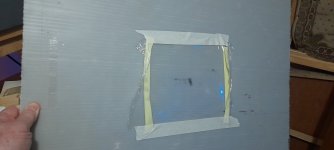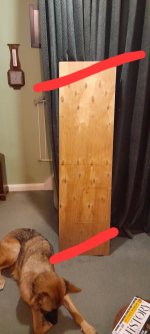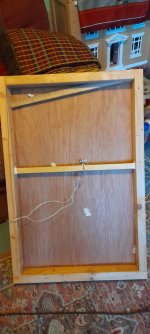The best I've found so far is dense Polyurethane foam that came out of a large ice cooler, a YETI style ice cooler. A combination of this with a small thin wood ply glued in a hole cut in the center with the 25FHE-4 exciters is what I've been listening to for over a year now. Do a search of my post's. The Poly foam sounds great on it's own as well. I like warmer sound so not for everyone. Second is some thin, very dense EPS. Third is thin ply, I've been looking in pawn and thrift stores for a couple of old, flat backed guitars to use the wood off the backs as panels.Which material is considered good or best for a DML panel?
Hello Freedom666As this thread is so long.
Who has an overview?
Which material is considered good or best for a DML panel?
Here is the link to my AudioDIY DML Github page. There is one history file of this thread but I stopped maybe 2 years ago now to update it.
In this page there is also a paper about the efficiency. It is clear that the lighter materials have a better efficiency but it seems there is also a relation to highest frequency they can reach which is not fully clear.
I made also directivity measurements. From that, I would only keep materials that have a coincidence frequency let say above 10kHz and no SPL off axis higher than on axis.
So a material light (for the efficiency) and flexible (for a high coincidence frequency). This goes against the "light and stiff" frequently shared in threads about DML!
From my tests (I haven't tested all the possible materials!) this leads to thin and light plywood, the transparent polystyrene probably in 2mm (this one is probably too heavy) and an outsider I haven't fully tested which is the Depron in 9mm (I just added the 6mm version to my set of tests). For the plywood it is 3mm max, probably even 2mm made from poplar or basswood. EPS is also a possibility, in 10mm for light density, thicker for large panel in high density.
The EPS is a bit different as it cuts, at least in low density, in frequency before 20k.
There are common points in this approach to what Steve (@spedge) listed. He has in addition the cardboard (in my waiting list for directivity test) and the proplex which is a corrugated polypropylene with round flutes not easy to source.
The common point with @toddincabo 's post is the thin plywood.
The materials to avoid for a wide range panel (= which goes to the highs) : XPS in 20mm, standard plywood from 5mm, corrugated polypropylene with square flute.
A lesson I learnt from Steve is "don't go to fast in the panel building/modification". Be prepared to use several samples, start by gluing an exciter on the raw material, listen and if possible measure and better measure in directivity and then modify. The PVA glue allows to use the same exciter on different panels. The panel will be probably a bit damage when you remove the exciter, the exciter should remain ok.
Christian
This is a plot of a 3mm ply panel I posted over on NXT Rubbish about 15 years ago.
You can see the rising response in the hf and the hump above 10k.
The thin dots are the response from the front of the panel. The lower thick bars are the response from a side angle of the panel.
The hump above 10k is still there ,but obviously everything is at a lower level.

You can see the rising response in the hf and the hump above 10k.
The thin dots are the response from the front of the panel. The lower thick bars are the response from a side angle of the panel.
The hump above 10k is still there ,but obviously everything is at a lower level.
Hello Trenth.
My youtube site also has many different materials I have used, including my favourite EPS.
It is nice to hear and see them in action.
Steve.
My youtube site also has many different materials I have used, including my favourite EPS.
It is nice to hear and see them in action.
Steve.
Also if using tall panels of ply, I would recommend either cutting the panel or using braces in the positions shown in this picture.
This prevents the build up of low frequency resonances causing a low frequency drum effect.
I used a large vice to clamp two solid pieces of wood at an angle, this was enough to support the panel with no other mounting needed.
I also used braces on my rigidly mounted 2x3ft 3mm ply panels.
Steve.
This prevents the build up of low frequency resonances causing a low frequency drum effect.
I used a large vice to clamp two solid pieces of wood at an angle, this was enough to support the panel with no other mounting needed.
I also used braces on my rigidly mounted 2x3ft 3mm ply panels.
Steve.
Attachments
The tall panel in my last post was 5mm and 5ft tall.
And was perfectly capable of supporting itself without a frame.
Steve.
And was perfectly capable of supporting itself without a frame.
Steve.
Years ago when first reading this thread it seemed obvious that the holy grail of "Full Range DML" is not happening, at least not with a single panel if you want good bass, seems to still hold true. Forget about that and get yourself or build a nice sub. Use resistors or a x-over to allow the panels to do their thing without having to worry about the lows. My old Sony receiver has a setting to allow for that.Which material is considered good or best for a DML panel?
Not sure the target is the same for DML.from my experience with sandwich cones of classic loudspeaker drivers alu foil - paper - alu foil I would go for that
or
3mm polystyrene sandwiched between metal foils
(household alu foil)
For cone, my understanding of your technique is it increases stiffness and damping (and probably mass mainly with the glue) in order to decrease the break up effects. It seems similar to a constraint layer damping.
It would be interesting to see the effect on the T/S parameters (mainly the mass) and the directivity of the tweaked cones. Maybe it is already in one of your posts?
For DML, I think there is an agreement to say a certain level of modes is expected.
The few tests I did with homemade ply was with PVA. Too damped. There are similar other feedbacks.
For the core material, it is expected to have a high enough shear modulus so that it is the skin elasticity that works. It is why in most of the composites proposed for DML, the core is a honeycomb or end-grain balsa.
Christian
@homeswinghome
there are two qualities of aluminium foil.
one is very thin from the goldsmith the other is
household foil and silicone sealant.
The latter has more impact on the mass and TSP.
Directivity and mass are not the main construction aims of the diy alu foil tweak:
both parameters can be influenced otherwise.
From the measurements most effective is reduction of resonances which can be observed in waterfall measurements.
Distortion plays a role, too. Although I did not measure that often.
What changes completely is:
cleanliness in sound
high frequency behaviour
impulse response
there are two qualities of aluminium foil.
one is very thin from the goldsmith the other is
household foil and silicone sealant.
The latter has more impact on the mass and TSP.
Directivity and mass are not the main construction aims of the diy alu foil tweak:
both parameters can be influenced otherwise.
From the measurements most effective is reduction of resonances which can be observed in waterfall measurements.
Distortion plays a role, too. Although I did not measure that often.
What changes completely is:
cleanliness in sound
high frequency behaviour
impulse response
Most of the materials I tested in directivity (not to say all) show a hump in the 10k range. The cause is the behavior of the central area in the voice coil ring.This is a plot of a 3mm ply panel I posted over on NXT Rubbish about 15 years ago.
You can see the rising response in the hf and the hump above 10k.
It reminds me I haven't finished tests about that to see if a local reinforcement solves the problem. I have tested the solution of a hole but I got the same result I already had some time ago : it kills the HF without solving the problem of the high SPL on the rear in the 2 to 4k range. In the list of counter-measures against the peak : reinforcement (there are patents in this way), reduce thickness (= inverted dome?), Eucy dome, damping (already tested by somebody - sorry I don't remember who..., I did some quick tests in the past without a big success)
Christian
I have in mind you use household one. Correct?there are two qualities of aluminium foil.
one is very thin from the goldsmith the other is
household foil and silicone sealant.
It reminds me I thought to make tests with those household foil. There is even one brand which proposes a more rigid foil thanks to small hexagon shape.
This is from post 10429
@homeswinghome
I would assist a DML always with dsp power reducing the development time for getting a good frequency response.
I do this always with my fullrange drivers.
Already some smartphone EQ is of great help for that making EQ easy accessible and cheap at the same time.
So with a DML the panel itself makes the music like the quality of the cone with fullranges.
If you want a big fullrange behaves like a DML where the cone breaks up.
Here measurements of a paper cone one side with household alu foil behaving nearly resonance free
25cm fullrange measurements
I would assist a DML always with dsp power reducing the development time for getting a good frequency response.
I do this always with my fullrange drivers.
Already some smartphone EQ is of great help for that making EQ easy accessible and cheap at the same time.
So with a DML the panel itself makes the music like the quality of the cone with fullranges.
If you want a big fullrange behaves like a DML where the cone breaks up.
Here measurements of a paper cone one side with household alu foil behaving nearly resonance free
@perrymarshall
Usually you have to build ready developed loudspeakers from DIY loudspeaker magazines if you have no measurement equipment.
If you try without assistance (no magazines, no measurement system, no listening experience, no knowledge how to do it) the way is stoney to make a good loudspeaker and usually most commercial designs will sound better.
But with experience and time you learn to do things which you cannot buy anywhere.
For example a simple 15cm fullrange driver which in a 29 liter reflex box made perfect sound, no crossover at all it goes up to 12khz...
Usually you have to build ready developed loudspeakers from DIY loudspeaker magazines if you have no measurement equipment.
If you try without assistance (no magazines, no measurement system, no listening experience, no knowledge how to do it) the way is stoney to make a good loudspeaker and usually most commercial designs will sound better.
But with experience and time you learn to do things which you cannot buy anywhere.
For example a simple 15cm fullrange driver which in a 29 liter reflex box made perfect sound, no crossover at all it goes up to 12khz...
25cm fullrange measurements
Hello Ro808,
I just wanted to show a driver which is rarely built, a true 15 inch fullrange driver with high spl.
If you use dsp correction the driver will be linear on axis. Off axis is a different thing.
The modified driver will be always linear after dsp use.
On the Fane website is the data sheet
SOVEREIGN 15-300TC
Here you can see a 10 inch driver fullrange going down to 35 Hertz in Reflex, dsp corrected, both sides of the diaphragm is aluminium covered. Dustcap is aluminium hand made. It is not optically perfect but acoustically its o.k.
The ringing in the high frequencies...
I just wanted to show a driver which is rarely built, a true 15 inch fullrange driver with high spl.
If you use dsp correction the driver will be linear on axis. Off axis is a different thing.
The modified driver will be always linear after dsp use.
On the Fane website is the data sheet
SOVEREIGN 15-300TC
Here you can see a 10 inch driver fullrange going down to 35 Hertz in Reflex, dsp corrected, both sides of the diaphragm is aluminium covered. Dustcap is aluminium hand made. It is not optically perfect but acoustically its o.k.
The ringing in the high frequencies...
The easiest way of damping that 10khz peak on EPS I've found is sticking a small (12 x 20 x 10mm approx) piece of EPDM foam in the centre of the voice coil area on the front of the panel. I haven't measured or noticed the rear peak but haven't looked for it. Still rolls off after 12khz but gets rid of the peak.Most of the materials I tested in directivity (not to say all) show a hump in the 10k range. The cause is the behavior of the central area in the voice coil ring.
It reminds me I haven't finished tests about that to see if a local reinforcement solves the problem. I have tested the solution of a hole but I got the same result I already had some time ago : it kills the HF without solving the problem of the high SPL on the rear in the 2 to 4k range. In the list of counter-measures against the peak : reinforcement (there are patents in this way), reduce thickness (= inverted dome?), Eucy dome, damping (already tested by somebody - sorry I don't remember who..., I did some quick tests in the past without a big success)
Christian
Just to clarify, what may be called "1/4" plywood may be as thin as about 4.5 mm, in my experience. In Europe the standards may be less tolerant of variation!I have no experience with "thick" plywood (1/4" = 6.35mm). I had a sample of 5mm standard (french) plywood in the directivity tests some weeks ago. I won't recommend it to go high. Its directivity characteristics were not good (high SPL out of axis at high frequency).
Eric
Hey yall. Anyone know of where I can buy tonewood or instrument-grade wood sheets, of the sizes that we generally are interested in? (roughly ~3mm, and roughly 12" x 24" minimum)
If anyone can find me a place to buy stock of this size I will build a set of speakers and report back.
If anyone can find me a place to buy stock of this size I will build a set of speakers and report back.
These guys ship worldwide. Sheets not exactly the size you want, but they cater for guitar makers.
https://maderasbarber.com/tonewood/en/content/22-about-us
https://maderasbarber.com/tonewood/en/content/22-about-us
Oof. I am in usa and shipping is twice the price of the stock. I am going to try find some local suppliers. the only difference will be that there is a soft ply inbetween the hardwood veneers, we will see how that works out...
- Home
- Loudspeakers
- Full Range
- A Study of DMLs as a Full Range Speaker


